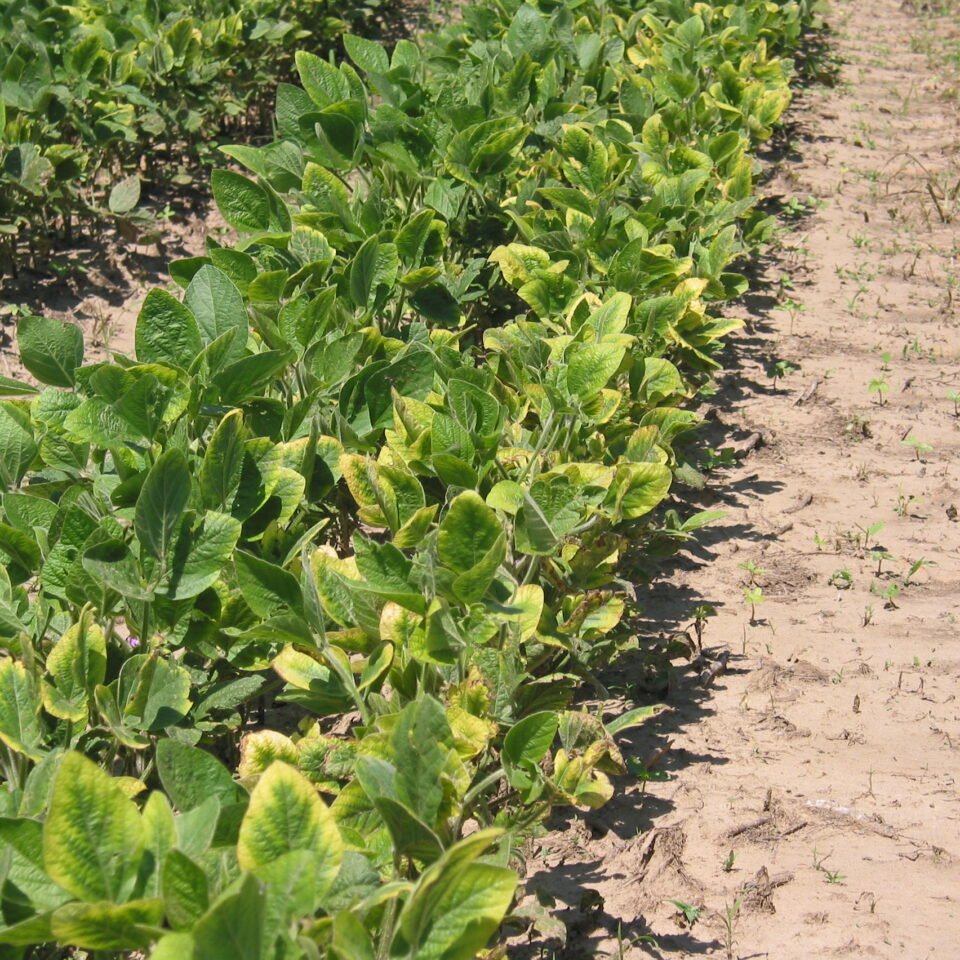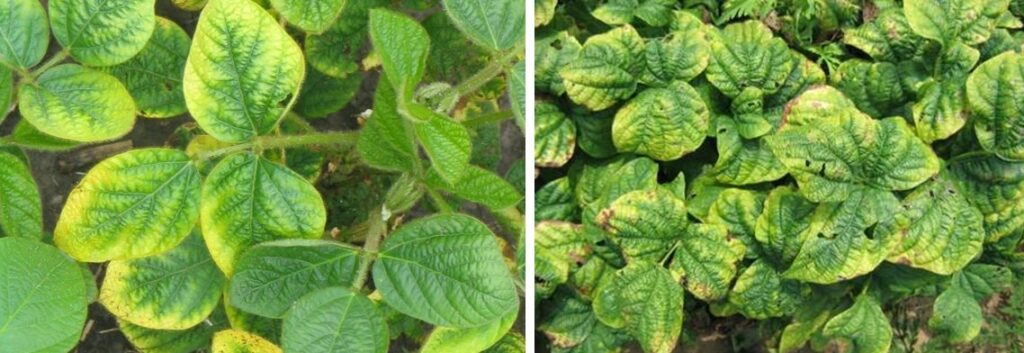
Nutrient Deficiencies
Nutrient deficiencies occur when plants are unable to take up the essential nutrients they need for growth at any point in the growing season. The first step in identifying a nutrient deficiency is to determine where on the plant the deficiency is appearing.
Mobile nutrients are able to move throughout the plant, wherever the nutrient is needed. As the nutrient becomes deficient, it is relocated to the younger tissue of the plant hoping to recover. This means that the older lower leaf tissue will show deficiency symptoms first, spreading to the remainder of the plant if supply or availability of the nutrient does not improve.
Immobile nutrients are not able to move throughout the plant, and stay where they were initially sent in the plant when they were taken up. As the nutrient becomes deficient, uptake has become limited in the new growth and the plant is unable to move nutrients from the older tissue in order to compensate, so the deficiency shows in the younger, upper leaves.
Misidentification
Some nutrient deficiencies can be very easily confused for other problems occurring in the field. For example, Calcium deficiency can often be confused with herbicide injury. You could also think that potassium deficiency is present in soybeans or edible beans when it is in fact insect damage from potato leafhopper. It is very important that you double check what you are seeing in the field is the issue. Tissue and soil testing are excellent diagnostic tools to ensure that a nutrient deficiency is in fact present in the crop.

ABOVE: Potassium deficiency (left) and potato leafhopper burn (right) can look very similar.
Sources: Field Crop News, UMass Extension
Primary Nutrients
Nitrogen (N)
Nitrogen is a mobile plant nutrient, so symptoms begin on the older lower leaves and then spreads to the remainder of the plant. Symptoms include a general yellowing of leaf tissue, and stunted plants. In corn, symptoms show up as a v-shaped chlorosis beginning at the leaf tip and advancing down the midrib. This chlorosis eventually turns into necrotic areas. Deficiency is commonly favoured by flooded or saturated soils, and dry soils later in the summer.
Phosphorus (P)
Phosphorus is a mobile nutrient, so symptoms first appear on the older lower leaves. Symptoms are usually associated with a purpling or reddening of leaf margins. Plants can also be stunted in early growth. As plants grow taller, deficiency can be more difficult to diagnose. Often confused with cold weather injury.
Potassium (K)
Potassium is a mobile nutrient, so symptoms initially show up on the older lower leaves. Symptoms include a yellowing of leaf margins, followed by necrosis of those margins as the deficiency continues. K deficiency can lead to poor stalk strength, which can lead to lodging in wheat and corn, especially when high rates of nitrogen have been applied to the crop.

ABOVE: Nitrogen (left), Phosphorus (middle) and Potassium (right) deficiencies in soybeans.
Sources: Dekalb AsGrow, ATP Nutrition, Field Crop News
Secondary Nutrients
Sulphur (S)
Sulfur is an immobile nutrient, and typically appears on the younger upper leaves first. It is similar to nitrogen deficiency in that symptoms show as a general yellowing of leaf tissue, along with stunted growth. It could also show up as interveinal chlorosis rather than a yellowing of the whole leaf. Early season deficiencies may disappear as soil conditions improve and more sulfur is made available from mineralization or as plant roots grow and reach more sulfur throughout the soil.
Magnesium (Mg)
Magnesium is a mobile nutrient, so symptoms show up first on the older lower leaves. It appears as yellow to white interveinal striping on leaves. Leaf veins can also become a reddish-purple colour and the tips and edges of the leaves can become necrotic.
Calcium (Ca)
Calcium is an immobile nutrient, with symptoms first appearing on the younger upper leaves. Symptoms show as browning and die back of growing tips of roots and leaves. Leaves curl and newly emerging leaves stick together at the margins, sometimes leading to expanded leaves being shredded along the edges. Can be easily confused as herbicide injury. Leads to blossom end rot in tomatoes.

ABOVE: Sulphur (left), Magnesium (middle) and Calcium (right) deficiencies in corn.
Sources: Dekalb AsGrow, University of Minnesota Extension, Iowa Agriculture Literacy Foundation
Micronutrients
Manganese (Mn)
Manganese in an immobile plant nutrient, with symptoms showing first on the younger upper leaves. Deficiency results in slightly stunted growth along with interveinal chlorosis. Can be confused with magnesium deficiency, with the area of the plant where symptoms are showing being the differentiating factor (Mn upper leaves, Mg lower leaves). Can lead to grey spots on leaves in cereals. Very common in soybeans.
Zinc (Zn)
Zinc is in immobile nutrient, so visual symptoms first show on the younger upper leaves. It appears as a pale yellow to white interveinal chlorosis. Plant growth becomes stunted and leaves eventually die and fall off the plant as the deficiency becomes more severe.

ABOVE: Manganese deficiency in soybeans (left) and Zinc deficiency in corn (right).
Sources: Michigan State University, DuPont Pioneer
Finding Nutrient Deficiencies in Your Crops?
Get in touch with your Sylvite Agri-Services Sales Representative or Ag Consultant to learn more about the crop nutrients and fertilizer products you can use to help your crops thrive this season!
Let’s Talk!
Featured Image: Mississipi Crop Situation
Additional Sources: IPNI